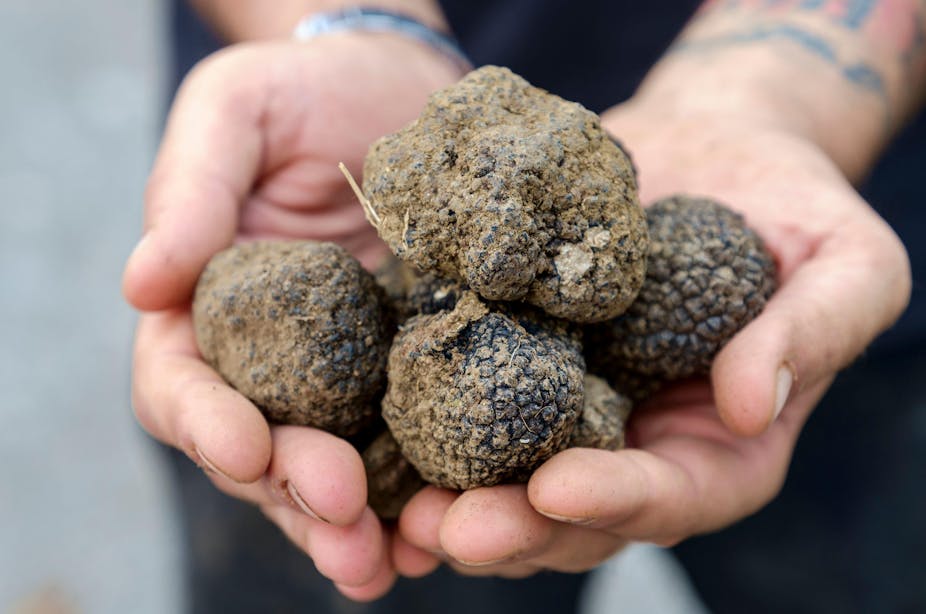Truffles, the prized fungi coveted worldwide by chefs and food connoisseurs, have long been held in high regard.
Often associated with Mediterranean Europe, especially France, Italy and Spain, these tasty fungi grow underground and are unearthed with the help of scent-detection dogs.
But unbeknown to many is the fact that the UK once had a thriving industry focused on a native truffle species (Tuber aestivum), with the English truffle first recorded in 1693.
From this point on there are many accounts of the UK’s thriving truffle industry, including writings by celebrated chef Mrs Beeton in 1861. However, changing socioeconomic conditions and a loss of habitat eventually led to a collapse of the industry, and truffle harvesting in the UK went to ground.
Some hunters were still able to find truffles. This was mainly for personal use, but some were still sold to local restaurants or pubs by lucky hunters – though only on a very small scale. Official markets had disappeared.
This slump wasn’t unique to the UK. A similar story played out in France, although the French had enough crops to keep the industry alive. The decline was eventually stemmed in France in the 1970s thanks to a new technique, whereby truffles were cultivated by inoculating the roots of oak and hazel trees with truffle spores.
News of this success spread to the UK, where truffle-inoculated trees from the Mediterranean began to be imported. But applying methods that worked in the Mediterranean to the UK’s temperate climate failed to produce any truffles.
This changed when my colleagues and I pioneered a new approach that took into account the UK climate. Rather than replicating Mediterranean methods, we instead focused on seeds and spores adapted to local conditions. This led to the harvest of England’s first cultivated truffle, in Leicestershire in 2015.
This was swiftly followed by Wales’ first cultivated truffle in 2016 and Scotland in 2017. And just across the water, the Republic of Ireland joined the group of Celtic truffle producers when two orchards began production in 2022.
This revival of the British and Irish truffle industries is particularly encouraging given my recent research shows that global production is at risk due to the climate crisis. But my work also suggests that UK truffles may be set to prosper in these conditions.
Truffles at risk?
Myself and a colleague have used historical data to anticipate the impact of climate change on truffle production. Our data suggests there will likely be a huge decline in Mediterranean harvests by 2071.
We are now starting to see evidence of this, with poor harvests linked to drier conditions. But what we hadn’t anticipated was the impact closer to home – with 2022 the worst UK truffle season in memory.
Although we are not yet sure exactly why this is the case, summer drought and heat can be detrimental to truffle harvests. And we saw this in the south and east of England, with high temperatures, little rainfall and reduced truffle production.
But in the north and west of England, where rainfall is typically higher and temperatures are cooler, the impact on truffle production was very different – with truffles harvested in record quantities.
Not many wild truffles exist in the north and west of England, as the soil isn’t as suitable. Truffles like calcareous bedrock, such as chalk or limestone, which results in alkaline soil. So the truffle orchards in these areas have had to make the soil more alkaline by applying agricultural lime.
Climate changing
Perhaps then 2022 presents a good example of what we can expect, in terms of truffles in the UK as climate change advances.
Wild production will struggle but orchards in the south and east of England could use irrigation to sustain harvests. Meanwhile, orchards in the centre, north and west of England may be far more resilient. However, offsetting the expected decline in Mediterranean production will be almost impossible.
But while climate most certainly impacts the growth and development of truffles, it may also be important in terms of reproduction. Indeed, truffle fungi require two different truffle “mating types”, akin to males and females in humans, to come into contact to produce the actual fruiting bodies, much like pollination in fruit crops.
Although we are not totally sure how this happens, more and more evidence indicates that invertebrates – such as the humble woodlouse – may help by eating small amounts of truffle and then moving spores (and the different mating types) which are then deposited in their faecal matter.

Crucially, in warmer and dryer conditions these invertebrates reduce feeding and movement, which results in fewer spores and mating types being moved around. So this is yet another way truffle production is negatively impacted by hotter and dryer conditions.
But climate change has also led to some unexpected benefits, too. In 2017, Périgord truffles (Tuber melanosporum) which are native to southern Europe and some of the most expensive truffles in the world, were grown for the first time in Wales.
This was possible due to the change in climate that has already occurred since the onset of the industrial revolution. Temperatures have increased just enough to allow this species to fruit.
Advancing climate change is a huge global problem, but in terms of truffles in the UK, it can be viewed as both a threat and an opportunity. Either way, Mrs Beeton would likely be happy to see the local truffle industry finally unearthed, once more.

Don’t have time to read about climate change as much as you’d like?
Get a weekly roundup in your inbox instead. Every Wednesday, The Conversation’s environment editor writes Imagine, a short email that goes a little deeper into just one climate issue. Join the 10,000+ readers who’ve subscribed so far.

